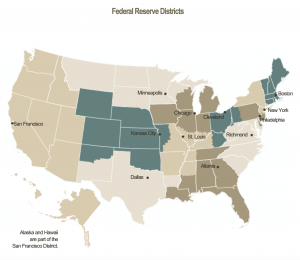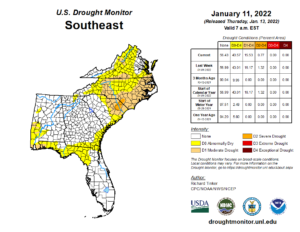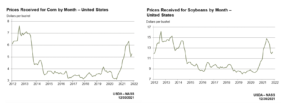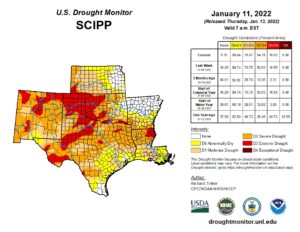Congress has quickly engaged in putting together potential aid packages for farmers that would more than double the Trump administration's $12 billion under the Farmer Bridge Assistance (FBA) Program.
Federal Reserve: Observations on the Ag Economy- January 2022
On Wednesday, the Federal Reserve Board released its January 2022 Beige Book update, a summary of commentary on current economic conditions by Federal Reserve District. The report included several observations pertaining to the U.S. agricultural economy.

* Sixth District- Atlanta– “Agricultural conditions remained mixed. Parts of the District experienced unusually dry conditions.

“The December production forecast for Florida’s orange crop was down from last year’s production while the grapefruit forecast was unchanged from last year’s production. The USDA reported year-over-year prices paid to farmers in November were up for corn, cotton, rice, soybeans, cattle, broilers, and eggs but down for milk. On a month-over-month basis, prices were up for corn, cotton, rice, soybeans, cattle, broilers, and milk, but down for eggs.”
* Seventh District- Chicago–
High prices and bumper corn and soybean harvests led to strong agricultural income in 2021.
“Agricultural lenders reported few issues with credit quality. Expectations are for income to be lower in 2022 than in 2021, as recent growth in input prices outpaced growth in agricultural goods prices and farmers expected the trend to continue. More crop farmers than typical applied fertilizer on fields during the fall because of expected cost increases and questions about future availability. Contacts also voiced concerns about pricing and availability of other inputs, with a jump in forward contracting to ensure supplies for 2022. Prices for corn and soybeans rose during the reporting period, supported by weather problems in South America and a pickup in ethanol production.

“Prices for cattle, hogs, eggs, and dairy products moved higher. Farmland prices stayed on a rapid upward trend.”
* Eighth District- St. Louis– “District agriculture conditions remain relatively unchanged since our previous report. The percentage of winter wheat in the District rated fair or better modestly increased from the end of October to the beginning of December, rising from 91 percent to 95 percent. This is a moderate increase over this period last year.
Average U.S. diesel and gasoline prices per gallon increased in the week ended Jan. 10, to $3.66 and $3.30, respectively https://t.co/jXg2e9aWmN pic.twitter.com/e8iHs8OaAw
— St. Louis Fed (@stlouisfed) January 12, 2022
“While contacts in the District are optimistic after a profitable year due to elevated commodity prices, they are also concerned about increased costs for fuel, fertilizers, and other inputs potentially affecting their crop production next year.”
* Ninth District- Minneapolis– “District agricultural conditions were steady since the last report. Crop production in Ninth District states exceeded earlier, drought-related predictions; however, production of some commodities (dry beans, for example) was much lower than 2020 levels.
Most contacts expected higher commodity prices to offset lower production and increased input costs, except in the hardest-hit areas.
* Tenth District- Kansas City– “Conditions in the Tenth District agricultural economy remained stable with ongoing strength in the sector. Farm revenues at year end were expected to reach multi-year highs due to elevated commodity prices, but contacts in the region reported further concerns about profit opportunities moving forward.
Substantially higher input costs remained a primary concern.
“In addition, while demand for most major commodities in the region remained strong and continued to support prices, export activity was lower than a year ago for some products as challenges associated with supply chains and port operations persisted. Contacts in the meatpacking industry reported that tight labor markets continued to limit production capacity, particularly for beef and hog processing facilities located in less populated areas where labor challenges have been more acute.”
* Eleventh District- Dallas– “Drought conditions worsened, with severe drought expanding in the northwest part of the District.

“Still, 2021 crop production was strong, particularly for cotton, out- stripping last year’s output thanks to more harvested acres and higher yields. Crop prices pushed higher during the reporting period, boosting sentiment among producers. However, contacts noted concerns over surging input costs and limited availability of herbicides and other items. On the livestock side, cattle prices pushed higher and demand for all meats remained strong. Outlooks are a bit uncertain, as dry conditions could restrain production prospects for next year.”
* Twelfth District- San Francisco– “Conditions in the agriculture and resource-related sectors remained mostly unchanged. Exporters of agricultural products continued to be challenged by shipping bottlenecks and port delays, with no signs of easing. As a result, one exporter reported selling more agricultural products domestically instead. Demand from food services was noted to have softened in recent weeks due to concerns related to the Delta and Omicron variants, while retail demand for agricultural products remained steady. Crop yields for tree fruit, nuts, and raisins were lower than anticipated due to weather effects and carry forward of low inventories in 2020. A grower in the Pacific Northwest noted that due to a lack of available domestic labor, many companies in the area have hired a higher proportion of foreign seasonal agricultural workers for this year’s harvest.”





